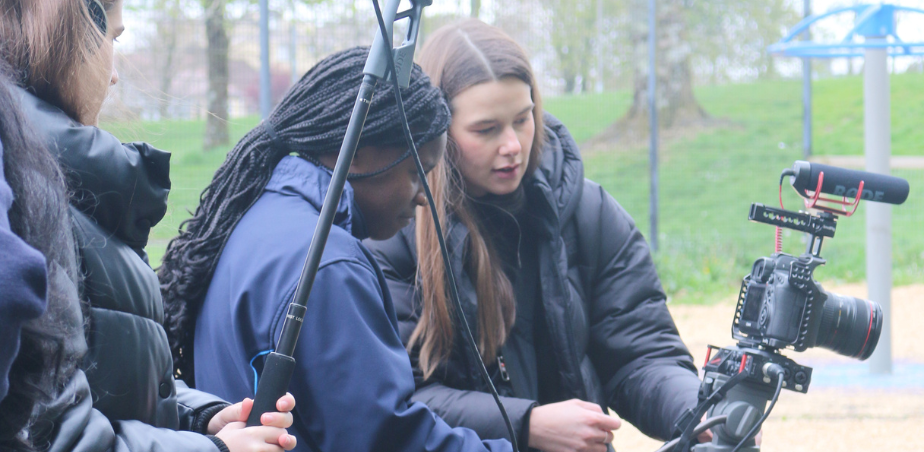Blog 1 – Coláiste Muire (Ennis) and Scoil Mhuire (Ennistymon), Co. Clare

2023 Arts in Education Portal Documentation Award, Keystone Project, Coláiste Muire, Ennis. Image Courtesy of Edel Doherty

The following blog posts have been written by art teachers Aidan Power and Mary Fahy along with their 5th Year class students in Coláiste Muire (Ennis) and Scoil Mhuire (Ennistymon), Co. Clare. They share their experiences of collaborating with artists Mitch Conlon and James Moran on the project Keystone, commissioned by Clare County Council to celebrate and mark 20 years of artist in schools programming by Clare Arts Office. The curatorial framework Art School, directed and curated by Jennie Guy, were invited to deliver the project, along with co-curator Fiona Gannon. This project is one of the recipients of the 2023 Portal Documentation Award, read the announcement here.
The new Leaving Certificate Art specification focuses on art as social commentary, political and social art and artists in the community, for this reason, the 5th Year students from the respective schools were selected to participate in the project.
A graduate of Limerick School of Art and Design – Honours Degree in Ceramics and HDip in Art Education, Aidan Power is a member of the Design and Crafts Council of Ireland Education Panel and worked as Regional Co-ordinator for the CraftEd primary school programme. He is currently a full time Art, History and CSPE teacher at Colaiste Muire Secondary School, Ennis and also continues to work on his own pastel chalk practice.
A Coláiste Muire Collective
I was instantly intrigued by the idea and inspiration behind the Keystone project. At its essence art should challenge our perceptions and viewpoints, provoke thought and discussion. By getting the students to focus on the local, and the everyday, they were challenged to reconsider their traditional concepts of what is worthy to be art. Moments in their own lives were investigated especially those centred around places they frequented around the town; their hang out spots.
These “spots”, these centres of interactions and events, often located in places unintended for that purpose; private places within shared spaces, offer teenagers a third space away from the restrictions and rules of home and school. A separate social dynamic for freedoms of expression and connectivity. Nevertheless, these places are normally frowned upon, considered loitering spots, adults tell youths to move on, to stop wasting time. The very idea that the artists wanted students to celebrate these places challenged their preconceptions of the value of these spots and in turn inspired further exploration.
The explorations brought us down a rabbit hole of new experiences where Mitch and James introduced the group to artistic influences such as the sound art of Mary Anne Amacher, and a documentary about protestors in Curraghinalt made by Emily MacFarland. Each piece inspired very much by the space they were captured in; the physical place and landscape told the story or was the story. This encouraged the students to go out and collect and gather content to tell theirs. They used sound recording, photography, written word and film. A multi-sensual catalogue of data was being built that would act as the primary source of a final realisation.
Our collective expanded further when the expertise of sound producer Liam McCartan and filmmaker Emily MacFarland were brought in to help build our content. Their choices, influenced by written reflections made by students, an interactive zoom call and on-site video shoot where students made creative inputs into all decision making. The experience of observing the layering and manipulation of individual sounds to produce a whole composition, along with the opportunity to use professional video production equipment was something I feel the students really enjoyed.
Seeing how, as the project developed, the students’ immersion within the project increased was something that was very enjoyable for me. Evident in their reflections their initial writings were basic literal descriptions of the sessions, but as the project developed and the students allowed themselves to become more absorbed, their writings became more conceptual considerations. They contemplated how themes could be communicated within the content; a swinging zipline rope from the playground could suggest isolation, a grove of trees in the fair green symbolised privacy in a public space. Their thoughts were now of symbolism and metaphor, associations were being sought outside of their literal meaning. This I believe was one of the greatest successes of the project; the opening of the student’s minds and realisation that all the resources they need to create and solve are often right there in front of them, they just need to give themselves time to look and observe.